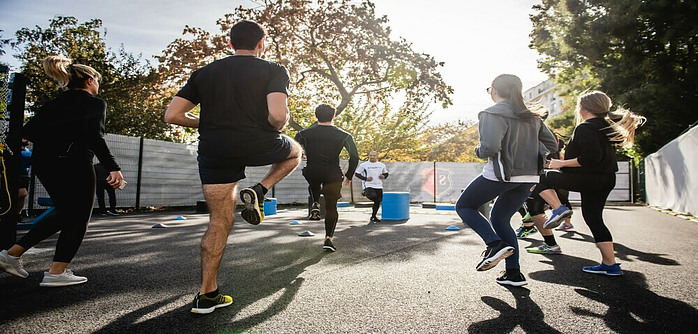Staying active is a crucial component of a healthy lifestyle, especially for seniors. I aim to shed light on why regular physical activity is not just beneficial but essential for older adults. From bolstering heart health to enhancing mental well-being, the advantages are manifold.
Yet, seniors often encounter hurdles that can deter them from maintaining an active lifestyle. These could range from physical limitations to a lack of motivation. Understanding these challenges is the first step in crafting a strategy to surmount them, fostering a can-do attitude towards staying active.
In the sections to follow, I’ll guide you through creating simple daily routines. This foundation will allow for a gradual build-up of physical activity that fits seamlessly into your life, ensuring that the move toward improved health is both enjoyable and sustainable.
Establishing Simple Daily Routines
You know that staying active is key, but where do you begin? The answer lies in the power of daily routines. Engaging in a variety of simple exercises that don’t demand much time or equipment is a sustainable starting point. I’m talking about routines that easily blend into your everyday life.
Remember, the aim isn’t to run marathons—it’s to ensure your body keeps moving. Marathons aren’t the goal here; movement is. A brisk walk around your neighborhood or a set of gentle stretches can do wonders. Consistency brings rewards over time, much more so than sporadic, intense workouts.
Integrating mobility exercises, like arm circles and knee lifts, or flexibility routines, such as yoga or tai chi, can greatly improve your range of motion and balance. These exercises are your allies in maintaining a supple and responsive body.
When I mention setting goals, I mean ones that are realistic and can be comfortably achieved. Perhaps you could aim for a daily 15-minute walk, gradually increasing the duration as you feel more comfortable. It’s about acknowledging your current ability and building from there.
Exploring Low-Impact Exercises for Endurance and Strength
You know how crucial it is to keep moving, especially as you grow older. But finding the right type of exercise that balances effectiveness with gentleness on your joints is key. Low-impact workouts are perfect in this regard, and there’s a variety of options to choose from.
Let’s start with swimming, for instance. It’s not just a refreshing way to cool down on a hot day; swimming provides a full-body workout that enhances endurance without stressing your joints. Then there’s walking, a fundamental form of exercise that can significantly improve your cardiovascular health with minimal risk. And if you enjoy the outdoors, cycling is another fantastic way to build stamina and enjoy nature simultaneously.
Strength training, too, isn’t off the table just because you’re a senior. Many exercises can be modified to suit your level of fitness and strength. Light weights or resistance bands can provide the resistance training your muscles need to stay strong and functional.
Exploring Low-Impact Exercises for Endurance and Strength
As we grow older, we sometimes think our bodies can’t handle the same activities we used to enjoy. However, the truth is that with the right approach, maintaining strength and endurance is still very much within reach. Low-impact exercises can be a cornerstone for a senior’s fitness routine, offering a safer, effective way to stay in shape without putting undue stress on the joints.
Swimming is a fantastic option for seniors. It provides a full-body workout that strengthens muscles, improves cardiovascular health, and minimizes strain on the body. Similarly, walking just 30 minutes a day can significantly boost heart health and maintain muscle tone. And let’s not forget about cycling, whether stationary or outdoors, which develops lower body strength and offers a heart-pumping workout.
Strength training, contrary to popular belief, isn’t just for the young. Seniors can perform bodyweight exercises, use light weights, or resistance bands to improve muscle mass, which is crucial for balance, bone health, and metabolism. Incorporating a couple of days a week of strength training can do wonders for a senior’s physical and mental health.
Low-impact aerobics are another great avenue for maintaining fitness. These exercises keep the heart rate up without the high impact of traditional aerobic workouts. Just remember, it’s essential to listen to your body. Start slow and gradually increase the intensity, always paying attention to how you feel during and after workouts. If anything feels wrong, stop and consult with a healthcare provider.
To ensure you’re exercising safely, consider working with a physical therapist or a certified fitness professional who can help tailor your routine to your needs and abilities. With their guidance, you can establish a regimen that bolsters your endurance and strength in a controlled, progressive manner.
Joining Social and Community Activities for Motivation
Staying active isn’t just a solitary endeavor; it’s an opportunity to connect with others and add a social element to your fitness routine. Group exercise is especially beneficial for older adults because it offers both physical and mental advantages. By participating in local sports clubs, classes specifically designed for seniors, or even group walks, you can find motivation through companionship.
Look for exercise classes in your area that cater to seniors. These classes often focus on safe, low-impact activities and are led by instructors trained in senior fitness. Yoga, Tai Chi, and water aerobics are excellent examples that blend social interaction with fitness.
Volunteering is another excellent way to stay active while giving back to the community. Whether it’s helping out at a local food bank, walking dogs for an animal shelter, or tending a community garden, these activities keep you moving and engaged with others.
In today’s connected world, there’s a wealth of virtual exercise communities to join. Online platforms can offer live classes, support groups, and challenges to keep you inspired. These resources are fantastic for days when traveling outside the home isn’t possible or when you’re looking for a new way to spice up your routine.
Monitoring Progress and Staying Motivated
I understand that maintaining enthusiasm for staying active can be a challenge. That’s why it’s essential to monitor progress to continually spark motivation and advance toward healthier senior years. Keeping an exercise diary is one straightforward strategy for tracking achievements. By jotting down daily activities and reflecting on accomplishments, you create a tangible reminder of your commitment to health.
Celebrating milestones is crucial. When you reach a target, treat yourself. It could be anything from a new book to a day out—whatever feels like a reward. Recognizing your hard work helps sustain motivation and keeps the momentum going.
As you become more active, you’ll notice changes in your fitness levels. It’s important to periodically adjust exercise routines to align with your evolving capabilities and interests. This helps to prevent boredom and adapts to your body’s changing needs. And if new activities spark your interest, don’t hesitate to try them out!
Finally, regular check-ups with healthcare providers cannot be overstated. These visits are an opportunity to discuss your exercise plans, get professional feedback, and ensure your activities align with your health status. Plus, it’s a chance for some external validation from a professional about the progress you’re making.









